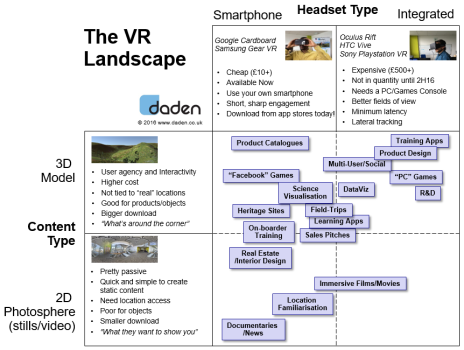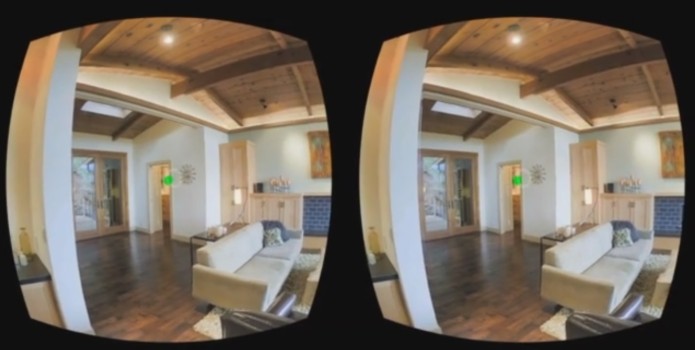
Right now, and probably for the next few years, there are two major dimensions that can be used to define different virtual reality solutions and experiences, and which tell you a lot about the costs, scope and feasibility of what is being described. The dimensions are:
- The kind of display that is used in the device
- The kind of imagery that is used in the device
In the first dimension, the kind of display, manufacturers typically choose between allowing the user to drop in their own smartphone, or building their own virtual display into the device.

In the second dimension, content creators typically choose between a fully-realized 3D environment, or from a 2D image or video “photosphere” wrapped around the viewer.
Both kinds of headset can be used with both kinds of content, creating four different major categories of virtual reality experiences.
Within the first dimension solutions such as Cardboard and Samsung Gear VR are typical of the smartphone approach. The big advantage of this is cost – the only added cost is the $10 cardboard. And while latency may not be as good as that of the integrated headsets, and quality will always be a movable feast — current phones being miles better the Oculus Rift DK2, but probably not as good as CV1 — for most consumers, it’s more than enough.
Oculus Rift and HTC Vive represent the other end of that dimension, the integrated approach, but the price and availability means they won’t be around in volume until at least the second half of this year, and probably not even until well into 2017. In fact, we’d probably lay bets on it not being until the second consumer version of the Oculus Rift is out that these solutions begin to get anywhere near the pervasiveness of Cardboard — which has already had well over five million units shipped.
The second dimension is about where does the source imagery in the virtual reality scene comes from. The two ends of that are 2D imagery delivered as photospheres or 360 degree video, or modeled 3D environments.
Of course we at Daden, and probably most of the readers of Hypergrid Business,  come from the latter space, so we’re always going to have an affinity for apps and content based around full-fledged 3D worlds.

But 2D does have its place. For example, 360-degree videos can be created quickly, and have a small download, for a start. But we always can’t help getting the feeling with 2D that we’re being shown what someone wants to show us. We always want to know “what’s round that corner.†We want an environment we can interact with, where we have agency, and ideally where there are other people too. That’s why we’re such a fan of social virtual reality.

But as professional developers, we think it’s important to talk potential clients through the whole two-by-two matrix so that they can see how the requirement they have map onto this two-by-two space, and that they make the best decision in terms of which content and device mix will best address their needs right now, and also gives them some ideas about trajectories for the future.
Some may note that augmented reality is not on the diagram, and nor are more traditional, desktop-based virtual worlds and immersive learning spaces. We’re tracking augmented reality and working on a “meta†diagram to try and place all these related technologies in their proper context.
You can download the full report for free here.
- Four major types of virtual reality - February 21, 2016
- Getting to grips with High Fidelity - November 7, 2015
- 5 key differences between virtual worlds and virtual reality - August 1, 2014
